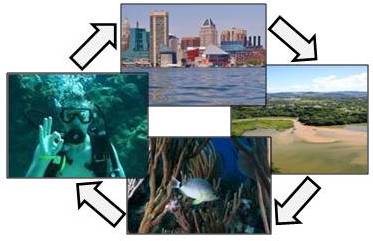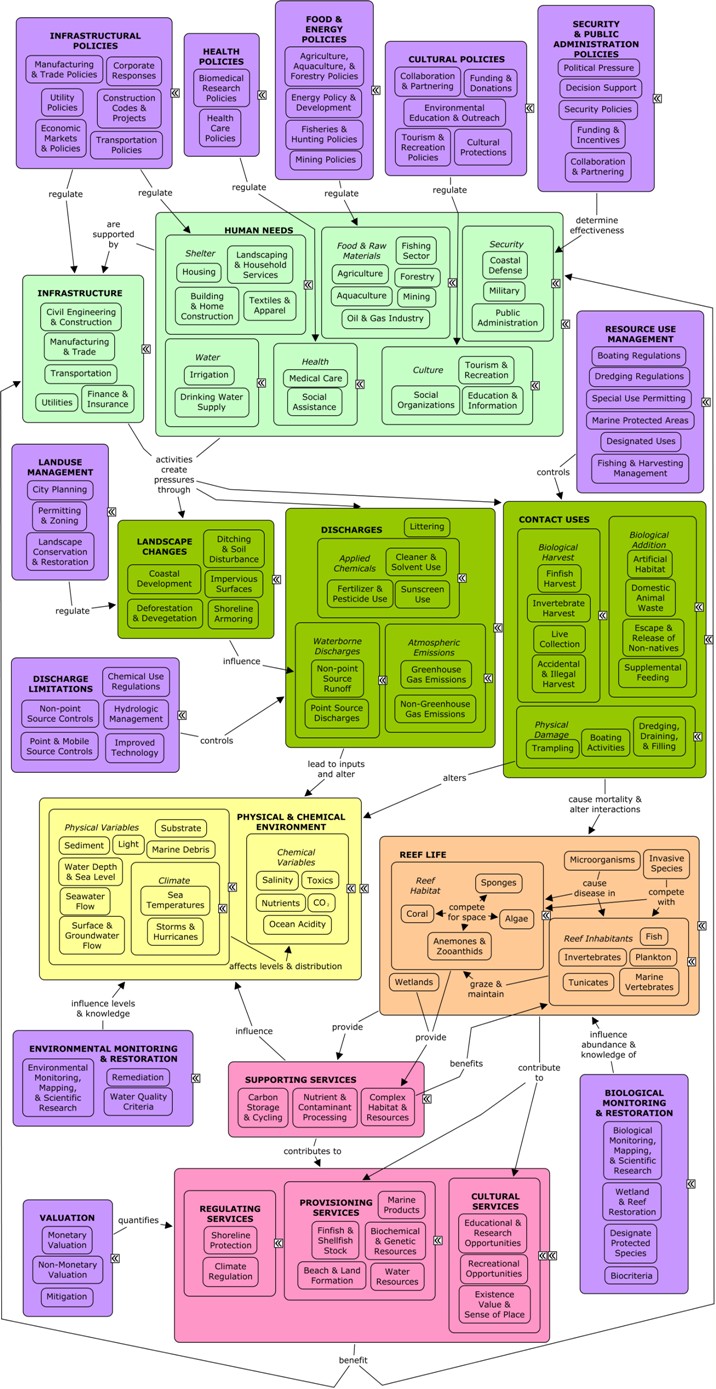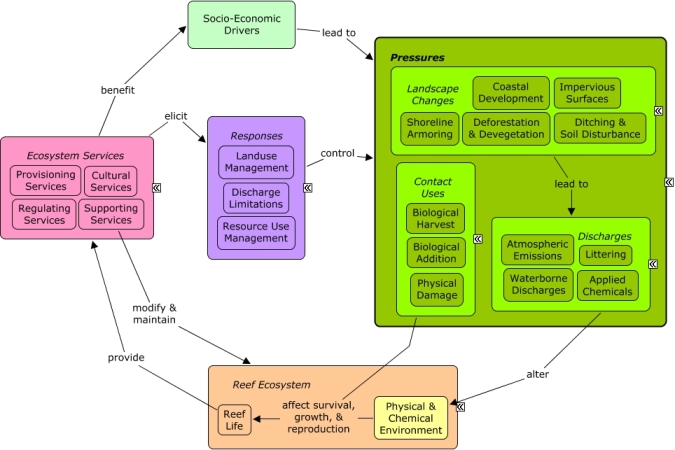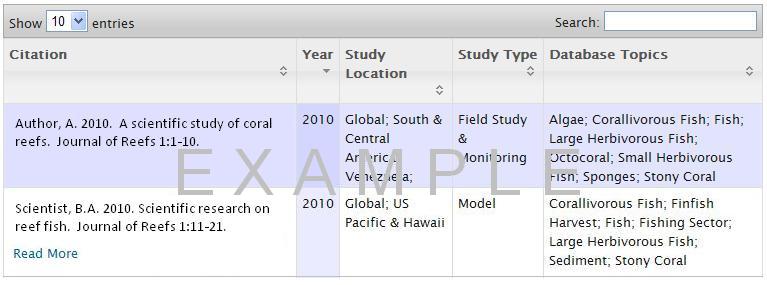ReefLink Database
ReefLink Database User's Guide
A Decision Support Tool for Linking Coral Reefs and Society through Systems Thinking

- 1.0 Background
- 2.0 Organizing Framework
- 3.0 Concept Maps
- 4.0 Information Database
- 5.0 How can I use the database?
- 6.0 References
Download User's Guide (PDF version, 11 pp, 0.7MB, About PDF)
1.0 Background
Coral reefs provide the ecological foundation for productive and diverse fish & invertebrate communities that support multibillion dollar reef fishing and tourism industries (Burke and Maidens 2004). Yet reefs are threatened by growing coastal development, climate change, and over-exploitation. Efforts by numerous federal, state, academic, and non-governmental organizations have generated a wealth of knowledge on coral reef ecology, yet reef ecosystems continue to decline (Wilkinson, 2008). A key issue is that scientific and management efforts are often narrowly defined. As a consequence, there is often difficulty in predicting the indirect consequences and benefits of decisions. There is an urgent need for a decision framework which integrates environmental concerns with social and economic needs.
2.0 Organizing Framework
The ReefLink Database utilizes a systems approach to integrate ecosystem services into the decision process, including elucidating the linkages between decisions, human activities, and provisioning of reef ecosystem goods and services. The database employs an overarching framework to ensure that critical concepts are not overlooked. The Driver-Pressure-State-Impact-Response (DPSIR) scheme is a flexible framework which characterizes causal links between five broad categories (EEA 1997, UNEP 2007, Maxim et al. 2009, Ojeda-Martinez et al. 2009).
Within DPSIR, Drivers (D) are social and economic forces which lead to human activities which create Pressure (P) on the State (S) of the environment, and Impact (I) the availability and value of ecosystem services. Decision-makers may enact a Response (R) to reduce the impacts on environmental resources through regulations, policies, and other decisions, which may alter Drivers (D) or Pressures (P), or directly affect the State (S) of the ecosystem. For more information, see the Tutorial on Systems Thinking using the DPSIR Framework.
The DPSIR framework is being employed to catalog, categorize, and organize a database of information including visual conceptual models illustrating relationships between concepts, scientific information, laws, and management options. Although our focus is on Caribbean reefs, keywords, concept maps, and database information were developed to capture broad ideas with widespread applicability to other reefs.

2.1 Hierarchy of Topics
The topics in the ReefLink Database were derived from literature searches and assembling focus groups of experts in reef ecology, economics, and decision-making. The DPSIR framework was employed to ensure key ecological, social, and economic topics were not overlooked. The five DPSIR categories are Socio-Economic Drivers (D), Pressures (P), the state of the Reef Ecosystem (S), the impact on Ecosystem Services (I), and Responses (R).
Broad sub-categories were developed within each of the five DPSIR categories. More specific topics are contained within each sub-category, often with more detailed sub-sub-categories or examples provided for each sub-category. Database information is provided for topics across all levels of the hierarchy (categories, sub-categories, or examples).
Categories and sub-categories are intended to serve as headings to organize a suite of related information. Categories are defined to reflect their usage within this database, rather than a strict definition of the term. Examples within each sub-category are provided, but the user should be aware that these are not intended to be all inclusive.
Hierarchy |
Topic |
|---|---|
DPSIR Category |
Pressures |
--Sub-Category |
--Discharges |
----Sub-sub-category |
----Atmospheric Emissions |
------Example |
------Greenhouse Gas Emissions |
Socio-Economic Drivers were derived from the North American Industrial Classification System (NAICS), the government standard which defines a comprehensive list of sectors of the economy. NAICS categories were slightly modified to reflect broad categories of human need, as well as to emphasize certain sub-sectors that were particularly relevant to reef management, while collapsing less relevant sectors. Some sectors may fall under more than one category (recreational fishing for food & culture).
Pressures were largely derived from information on stressors, including coastal pollution and development, from the Environmental Protection Agency. Focus groups and literature searches were used to identify key stressors on reefs (Burke and Maidens 2004).
The pressures exerted by society may lead to unintentional or intentional changes in the state of the Reef Ecosystem, including the concentration and quantity of physical and chemical variables through inputs of contaminants or sediments, or climate change, as well as altering the abundance, size, and diversity of biological variables by causing mortality or altering interactions among species. topics describing the state of the Reef Ecosystem were largely derived from literature searches and focus groups.
Changes in the condition of the reef ecosystem impact the welfare or well-being of humans through the provisioning of reef Ecosystem Services. Categories of Ecosystem Services were largely derived from the Millennium Ecosystem Assessment (MEA 2005).
Humans make decisions in Response to the impacts on ecosystem services or their perceived value. Responses are actions taken by groups or individuals in society and government to prevent, compensate, ameliorate or adapt to changes in the state of the environment. Categories of Responses were derived from reviewing possible actions described by the Environmental Protection Agency, existing reef management plans for Guanica Bay, Puerto Rico and the Florida Keys National Marine Sanctuary, the Millennium Ecosystem Assessment (MEA 2005), as well as focus groups.
3.0 Concept Maps
Concept maps are a visual way to represent relationships between ideas. Concept Mapping is a useful tool for visualizing a shared understanding of knowledge, communicating complex ideas, and detailing a single topic within the context of a larger system (Heemskerk et al. 2003). Development of concept maps is highly subjective and the models presented here are intended to stimulate thought and provide examples. Users are encouraged to develop their own conceptual models for their specific situation.
Concept mapping diagrams illustrate the links between socio-economic sectors and the pressures they create on the reef ecosystem and consequently, the availability of reef goods and services. Decision-makers may enact responses to reduce impacts on environmental resources through regulations, policies, and other decisions.
Concept maps are read essentially as a sentence where boxes represent concepts which are linked by a phrase to form a preposition.
Concepts can be further added and linked to represent a complex system. The ReefLink Database includes two types of concept maps: a whole systems conceptual model and more detailed concept maps for each topic.
The Whole Systems Conceptual Model provides an overview of all topics and their connections.
3.1 Whole Systems Model
The Whole System Concept Map provides an overview of all topics, and connections between them, within the DPSIR framework. Connections are not intended to be all-inclusive (every possible connection between pairs of words), but are instead intended to represent general patterns.
The Whole Systems Model essentially provides a visual Table of Contents to topics contained within the database. Clicking on topics within the Whole Systems Model will direct users to expanded concept maps and database information for individual topic areas.

3.2 Concept Maps by Topic
From the Whole Systems Model, individual concept maps (Cmaps) are expanded and elaborated for given topic areas into individual, more detailed concept maps. Each individual concept map provides examples within the focal topic, and elaborates on the Socio-Economic Drivers, Pressures, Reef Ecosystem state, Ecosystem Services, and Responses associated with that particular focal topic.
Individual Cmaps also provide information on the definition of the topic. Categories and sub-categories are intended to serve as headings to organize a suite of related information. Definitions reflect this usage as a category, sub-category, or example, rather than a strict definition of the term.
A verbal description of each Cmap is also provided, to aid users in interpreting the visual diagram. Concept map diagrams were drawn to capture major ideas, while maintaining some degree of simplicity, and may not represent an all-inclusive visualization of all possible interactions between concepts.
Each Cmap also provides links to database information, including laws, management options, websites, and scientific information associated with a given topic area.

3.3 Navigation between Concept Maps
Individual Concept Maps elaborate on the Socio-Economic Drivers, Pressures, Reef Ecosystem state, Ecosystem Services, and Responses associated with the particular focal topic. Keywords are organized within a hierarchical classification system.
Users can quickly navigate between topics by clicking on each concept within a concept map, to provide additional or more detailed elaborations on connected concepts. For example, from within the Pressures concept map, click the boxes labeled Discharges, Reef Life, or Supporting Services to obtain more information on discharges that affect the reef, reef biota, or services provided by the reef.
4.0 Information Database
The ReefLink Database is an organizing framework for compiling information that may enhance the decision process, including laws, management options, websites, and scientific literature. Database information is organized by DPSIR keyword topics.
Because topics are organized within a hierarchy, users may access specific information or more general information by navigating through the keyword hierarchy.
Database information may be three ways:
- Whole Systems Model: provides a visual table of contents for the topic areas in the database and how they are connected. Select topic keywords to navigate to more detailed database information on individual Topic pages.
- Topic List and Glossary: provides a list of topic areas in the database, and the definitions used to build the database. Topics may be sorted hierarchically by DPSIR category, or alphabetically. Select any topic to navigate to more detailed database information.
- Information by Topic: provides the database information for each topic keyword. Click the tabbed pages to see more information including i) topic-specific cmaps, ii) scientific literature citations, iii) management options, and iv) laws. Select concepts within the cmap to explore connected topics or see more detailed examples.
4.1 Scientific Literature Citations
The Citations database gives scientific literature associated with each Topic keyword. Scientific literature was compiled using keyword searches in scientific literature databases and reviewed to assign DPSIR topic keywords to each article. Because of the immense number of records (>20000), we used a computer algorithm to assign topic keywords. Each topic keyword was assigned a list of synonyms, which could include examples, more detailed sub-categories within a category, or alternative spellings. The algorithm search through the abstract, title, and keywords of each citation looking for the synonyms, and if the synonym was found, assigned the topic keyword to that article.
- Sorting: Click the arrows in each column heading to sort the records. Citations can be sorted by author name, study location, or the type of study.
- Filtering: Records can be searched or filtered by any search term. The filter searches the article title, study location, study type, and database topic keywords.
- Navigating Pages: Records are separated into pages. Click Next page to navigate between pages.

4.2 Management Options
Management Options is a database of potential actions managers could enact, or encourage to be enacted, in order to protect reef ecosystems and the provisioning of ecosystem services. Management options were largely derived from best management practices and existing reef management plans. However, management options were entered in the database with non-specific wording so as to have broad applicability. Management Options were assigned DPSIR keywords so that decision options related to a particular socio-economic sector, pressure, or environmental concern could be targeted.
- Sorting: Click the arrows in each column heading to sort the records. Management options can be sorted alphabetically or by their source.
- Filtering: Records can be searched or filtered by any search term. The filter searches management option, description, source, and database topic keywords.
- Navigating Pages: Records are separated into pages. Click Next page to navigate between pages.
4.3 Laws
Laws are rules, policies, or regulations written and passed by a legislative body at an international, federal, state, or local jurisdication. Laws that may be applicable to protecting reef ecosystems were reviewed using literature and internet searches. Laws were specifically targeted for the United States of America, Florida, Virgin Islands, and Puerto Rico. Laws were assigned DPSIR topic keywords so that laws related to a particular socio-economic sector, pressure, or environmental concern could be targeted.
- Sorting: Click the arrows in each column heading to sort the records. Laws can be sorted by their legal citation, management organization, or jurisdiction.
- Filtering: Records can be searched or filtered by any search term. The filter searches the legal citation, purpose of the law, application to reefs, legislative actions, management organization, jurisdiction, and database topic keywords.
- Navigating Pages: Records are separated into pages. Click Next page to navigate between pages.
5.0 How can I use the ReefLink Database?
5.1 Public
- Learn how factors in your community may affect coral reefs
- Example: How might different socio-economic sectors affect the reef? Click on different Socio-economic drivers to learn more about each. Click on different Pressures to learn more about how human activities may affect reefs.
- Example: How might agriculture on land affect the reef?Identify which Pressures might be derived from Agriculture.
- Example: What socio-economic factors may be contributing to physical damage of the reef? Click on Socio-economic drivers which may cause Physical Damage to learn more about each.
- Learn about beneficial goods and services the reef provides
- Example: What are ecosystem goods and services? Click on different examples of Ecosystem Services to learn more about each.
- Example: How can we put a value on reefs? Click on Valuation alternatives to learn about different methods.
- Example: What socio-economic sectors may benefit from natural products provided by the reef? See different Marine products and learn which socio-economic drivers they may benefit.
- Learn how decisions may affect the reef and your community
- Example: How might coastal development policies affect the reef? Click on alternative Land management options to see what Pressures they may help control.
- Example: What are different options to manage fishing activities? Read through the table to see different Management options and resources where they have been described.
5.2 Scientists
- Learn how your research fits into the bigger system
- Example: What is the role of sponges in the system? Learn about interactions between Sponges and other organisms in the reef ecosystem, ecosystem services sponges provide, and pressures which may affect sponges.
- Example: What are the connections between wetlands and the reef?Identify supporting services that Wetlands provide.
- Example: How might excess nutrients affect the reef?Identify the role of Nutrients in the reef ecosystem and organisms which may contribute to processing excess nutrients.
- Identify decision scenarios for which your research may be relevant
- Example: What might be causing high sediment levels and what options are available to reduce levels? Identify Socio-economic drivers which may contribute to Sediment discharge and potential Responses to reduce sediment.
- Example: Can water quality criteria be used to limit contaminants? Read about Water quality criteria.
- Find scientific literature relevant to your research
- Example: What research has been done linking elevated sea temperatures on sponges? Go to the Sea temperatures citations table and type "sponge" in Search box.
- Example: How many studies have attempted to place a monetary value on coral reefs? Scroll to bottom of Monetary valuation table and see number of entries.
- Learn how systems thinking might be applied to research
- Example: How can a conceptual framework like DPSIR aid in systems thinking? Read the Tutorial on systems thinking
- Example: What keywords might go into a conceptual framework? See the list of DPSIR Keywords for coral reefs.
- Example: Can I see an example using systems thinking organize information on coral reefs?
5.3 Managers
- Learn how systems thinking can aid in decision-making
- Example: How can a systems framework help to anticipate unintended consequences? Read the Tutorial on systems thinking
- Example: Can I see an example of a conceptual systems model for coral reefs? Examine the complexity of relationships between humans and Coral reefs.
- Learn about alternative management options
- Example: What might be causing high nutrient levels and what options are available to reduce levels? Identify Socio-economic drivers which may contribute to Nutrient loading and potential Responses to reduce nutrients.
- Example: What are different options to manage fishing activities? Read through the table to see different Management options and resources where they have been described.
- Learn which stakeholders which may be positively or negatively impacted by decisions
- Example: What socio-economic sectors may be affected if discharge limitations are implemented? Click on different types of Discharges to see which industries may be creating them.
- Example: What socio-economic sectors benefit from goods & services reefs provide? Click on different types of Ecosystem services to see which socio-economic sectors may benefit from them.
6.0 References
- Burke, L. and J. Maidens 2004. Reefs at Risk in the Caribbean. Washington D.C.: World Resources Institute.
- EEA (European Environment Agency). 1999. State and pressures of the marine and coastal Mediterranean environment. Environmental assessment series. Copenhagen, Denmark: European Environment Agency.
- Heemskerk, M., K. Wilson, and M. Pavao-Zuckerman. 2003. Conceptual models as tools for communication across disciplines. Conservation Ecology 7: 8
- Maxim, L; Spangenberg, JH; O'Connor, M. 2009. An analysis of risks for biodiversity under the DPSIR framework. Ecological Economics 69:12-23
- Millenium Ecosystem Assessment (MEA) 2005. Ecosystems and Human Well-being: Current State and Trends, Volume 1. Washington, D.C.: Island Press.
- Ojeda-Martinez, C; Casalduero, FG; Bayle-Sempere, JT; Cebrian, CB; Valle, C; Sanchez-Lizaso, JL; Forcada, A; Sanchez-Jerez, P; Martin-Sosa, P; Falcon, JM; Salas, F; Graziano, M; Chemello, R; Stobart, B; Cartagena, P; Perez-Ruzafa, A; Vandeperre, F; Rochel, E; Planes, S; Brito, A. 2009. A conceptual framework for the integral management of marine protected areas. Ocean & Coastal Management 52:89-101
- UNEP 2007. Global Environment Outlook. GEO4, Nairobi & Valletta, 540 p.
